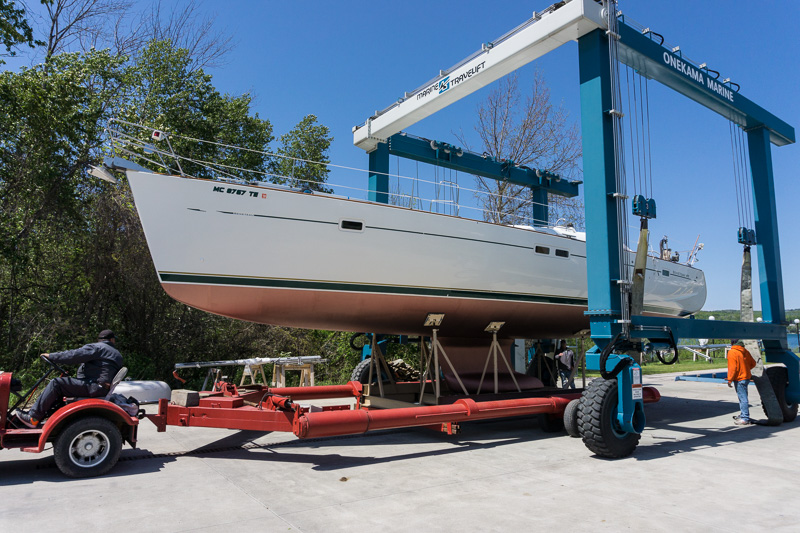
As I mentioned in our “unwinding from a previous lifestyle” post, we had some work to do to get our sailboat ready for spring launch and put up for sale. We completed that work and she recently went in the water for the season. It’s an interesting process.

We store the boat indoors during the winter and she sits on a custom made cradle to keep her upright. The first step is to get a hydraulic trailer under her to lift both the boat and cradle as one unit, below left. Once that’s done the crew carefully maneuvers her out of the storage building. They pack the boats in pretty tight so usually it’s a musical chairs process to clear a path to the door. Once out of the building it’s a short drive to the Travelift, below right.


The marine Travelift is an ungainly contraption that’s absolutely vital to get large boats in and out of the water. The boat and trailer is positioned under the lift and large straps are then connected under the boat, below left. Once everything is set, the Travelift hoists the boat straight up off the cradle, below right.


The trailer and cradle can then be pulled out from under the boat and she is then left hanging by the straps, below left. One of the maintenance tasks before she goes in the water for the season is to paint the bottom. You can see the copper colored paint in several of the pictures above. There are several spots you can’t paint while she’s sitting in the cradle so now is a good time to catch those. Fortunately the paint dries very fast. The Travelift then drives over a special boat slip and lowers her down into the water, below right.


If she were a power boat that would be it but she needs one more very important thing. A mast! Obviously to store a sailboat indoors you have to remove the mast and that was done last fall. Now it has to be re-installed or “stepped”. It’s pretty heavy and 60′ long so a crane has to be brought in to take care of this job. A strap is fastened a little more than half way up the mast and all the steel cables (shrouds & stays), ropes (running rigging) and electrical wires are arranged at the base of the mast.

The lift is then started and slowly the mast is brought upright while the crew on the ground guides the base of the mast, below left. The mast is lowered through a hole in the deck called the mast partner. It goes all the way to the bottom of the boat and rests on the keel. This configuration is called a keel stepped mast. Another configuration is where the mast rests on top of the deck and then a compression post runs from the keel to the underside of the deck to support the weight. That one is called a deck stepped mast. In the center photo below, the crew slowly lowers the mast through the mast partner down to another crew member below decks who guides it to the mast step. Once set, the crane can unhook and the task of fastening all the stays, shrouds and running rigging starts, below right. Getting all that properly tensioned and all the lines put in the proper place takes about a half day. Karen and I take care of that job.



So there you have it. How to launch a sailboat in a few easy steps. A good boat yard with experienced crew certainly makes it look easy. Even with their help, it’s still a lot of work getting her ready every spring. I’ll be listing her for sale soon and with any luck it will be our last spring launch. I kinda hate to see her go but at the same time I look forward to the freedom of being able to travel during the summer without worrying about the boat back home in the slip. We have too many places we want to go and this is one more of the big things to unwind.

